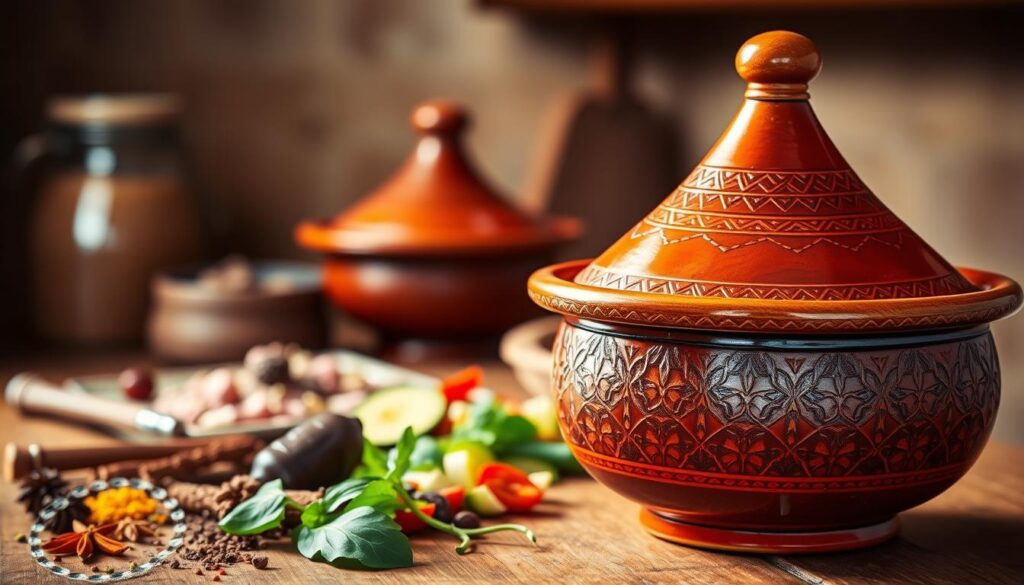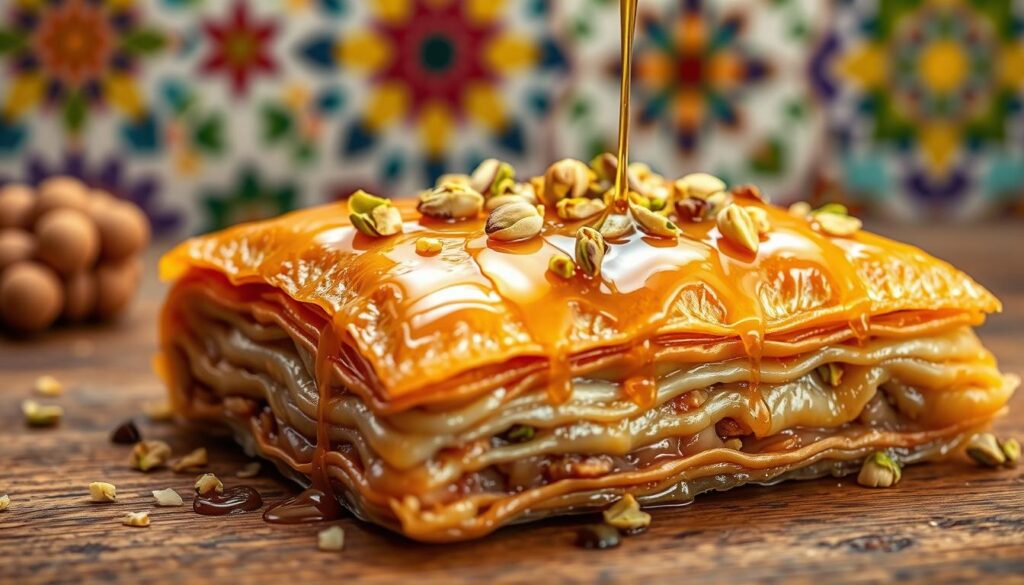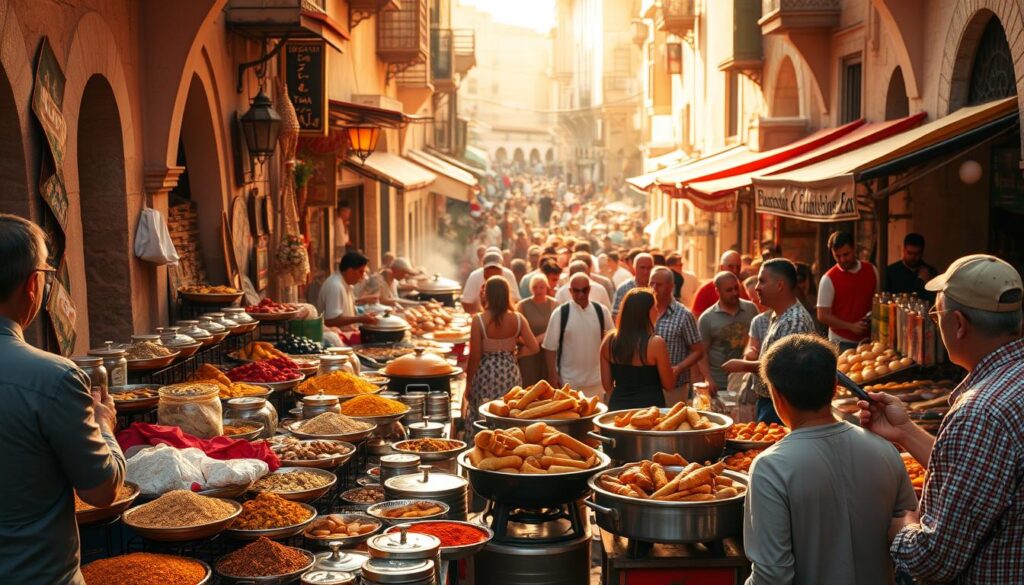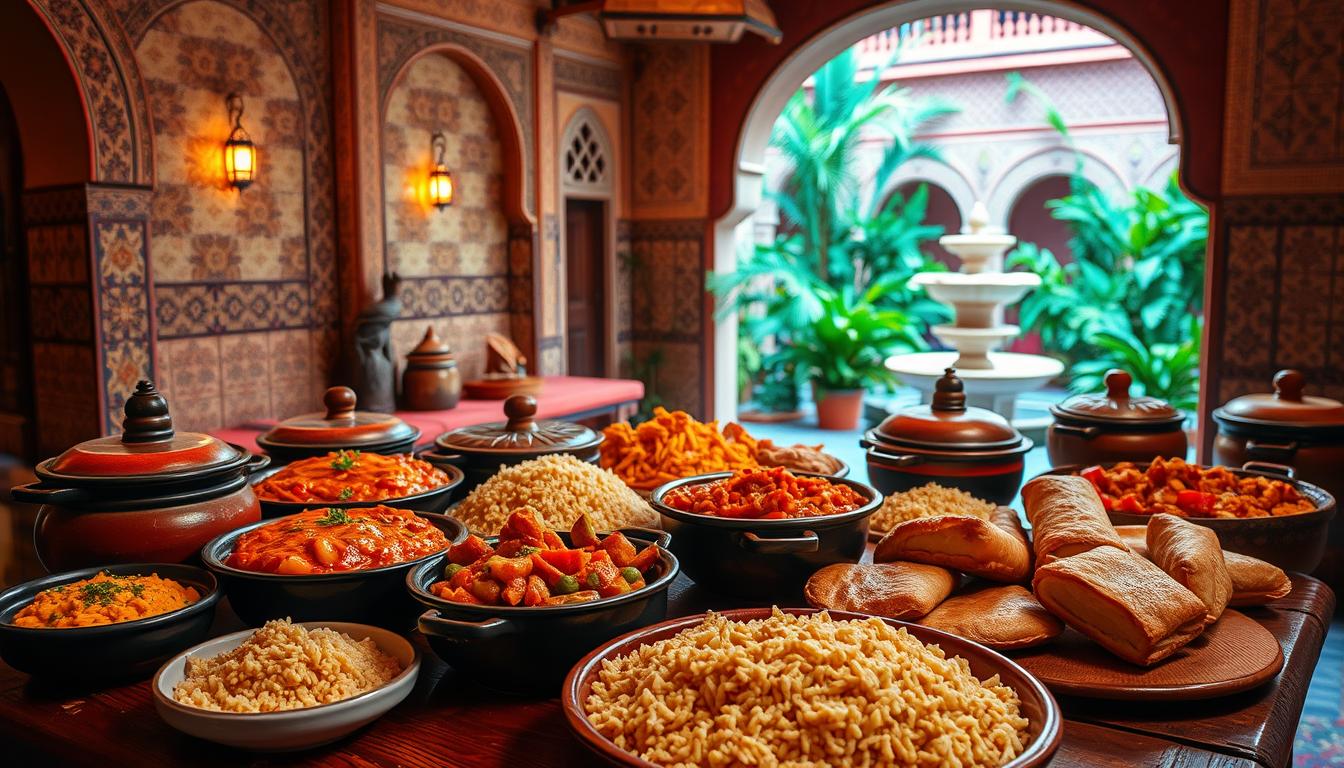Have you ever wondered what makes Moroccan cuisine so unique and flavorful?
Morocco, a country with a rich culinary history, offers a blend of Arabic, Mediterranean, and African flavors. This blend creates a gastronomic experience like no other. From savory tagines to sweet pastries, the variety of delicious dishes is vast.
Embark on a culinary journey through Morocco and discover the top dishes that define its cuisine. This article will guide you through the history, ingredients, and cultural significance of these beloved dishes.
Key Takeaways
- Discover the unique flavors and ingredients of Moroccan cuisine.
- Learn about the cultural significance of traditional Moroccan dishes.
- Explore the history behind Morocco’s most beloved culinary delights.
- Find out how to recreate these dishes at home.
- Get insights into the blend of Arabic, Mediterranean, and African flavors.
The Rich History of Moroccan Cuisine
The flavors and aromas of Moroccan cuisine tell the story of a country’s diverse cultural heritage. Moroccan cuisine is not just about the food; it’s an experience that reflects the country’s history, geography, and cultural interactions.
Influences on Flavor and Ingredients
Moroccan dishes are characterized by a blend of flavors and ingredients influenced by Arabic, Mediterranean, and African cuisines. The use of olives, olive oil, and spices like cumin and coriander is prevalent. These ingredients not only add flavor but also reflect the historical trade and cultural exchange that has shaped Moroccan cuisine.
Regional Variations in Cooking
Different regions in Morocco specialize in unique dishes based on local ingredients and traditional cooking methods. For example, the coastal regions incorporate more seafood into their dishes, while the interior regions focus on meat and vegetable-based recipes. This regional diversity is a hallmark of Moroccan cuisine, offering a wide range of flavors and dishes to explore.
Some common ingredients used across various Moroccan dishes include:
- Olive oil
- Cumin
- Coriander
- Fresh herbs like parsley and cilantro
The rich history of Moroccan cuisine is also reflected in its cooking techniques and the way meals are structured. For instance, the traditional Moroccan tagine is not just a dish; it’s a cooking method that slow-cooks ingredients in a clay pot with a conical lid, allowing flavors to meld together.
By understanding the influences on Moroccan cuisine and its regional variations, one can appreciate the complexity and richness of this culinary tradition. Whether you’re exploring traditional Moroccan food or trying out Moroccan food recipes at home, there’s a wealth of flavors and stories to discover.
Iconic Dishes You Must Try
When exploring Moroccan cuisine, there are several dishes that stand out for their cultural significance and delicious taste. These dishes not only represent the country’s culinary heritage but also offer a glimpse into its rich history and traditions.
Tagine: The Heart of Moroccan Cooking
Tagine is a quintessential Moroccan dish named after the earthenware pot in which it’s cooked. This slow-cooked stew is typically made with meat, vegetables, and dried fruits, all flavored with a blend of aromatic spices. The slow cooking process allows the flavors to meld together, creating a rich and satisfying meal.
Key ingredients in a traditional tagine include meat (usually chicken, beef, or lamb), onions, garlic, ginger, and a mix of spices such as cumin, coriander, and cinnamon. The dish is often cooked with dried fruits like apricots or prunes, adding a sweet and tangy flavor.

Couscous: A Staple and Celebration Dish
Couscous is another staple in Moroccan cuisine, often served on special occasions and celebrations. It consists of small steamed balls of semolina flour, typically served with a variety of vegetables and meats. The dish is highly versatile and can be adapted to suit different tastes and preferences.
Couscous is usually served with a mixture of vegetables such as carrots, zucchini, and bell peppers, along with meat or fish. The steaming process gives couscous its light and fluffy texture, making it a delightful accompaniment to a wide range of sauces and stews.
- Couscous is traditionally cooked on Fridays and special occasions.
- It is often served with a variety of toppings, including vegetables, meats, and sauces.
- The dish is highly versatile and can be adapted to different regional and personal preferences.
Pastilla: A Sweet and Savory Pie
Pastilla is a savory pie that combines the sweetness of onions and spices with the richness of meat, typically made with layers of flaky pastry. This dish is a delicacy in Moroccan cuisine and is often served at special occasions.
The filling of pastilla usually includes meat (such as chicken or pigeon), onions, and a blend of spices. The combination of sweet and savory flavors, along with the crunchy texture of the pastry, makes pastilla a unique and delicious experience.
Preparing pastilla involves layering the filling with pastry and baking until golden brown. The result is a dish that is both visually appealing and flavorful.
The Role of Spices in Moroccan Dishes
In Moroccan cooking, spices are not just additives; they are the essence that transforms simple ingredients into culinary masterpieces. The strategic use of spices is what sets Moroccan cuisine apart, giving it a unique and aromatic flavor profile that is both complex and inviting.
Common Spices and Their Uses
Moroccan cuisine relies heavily on a variety of spices, each contributing its distinct flavor and aroma. Cumin, coriander, and cinnamon are staples, used to add warmth and depth to dishes like tagines and stews. Turmeric is another common spice, valued for its vibrant color and health benefits. The blend of these spices, known as “ras el hanout,” is a hallmark of Moroccan cooking, allowing cooks to create unique and complex flavor profiles.
As noted by food experts, “The art of blending spices is a skill passed down through generations in Moroccan cuisine.” This traditional knowledge is crucial for creating authentic Moroccan dishes that are both flavorful and aromatic.
How to Balance Flavors with Spices
Balancing flavors with spices is an art that requires understanding the characteristics of each spice and how they interact with different ingredients. The key is to achieve harmony among the various flavors, ensuring that no single spice overpowers the dish. For instance, the sweetness of cinnamon can balance the heat of chili peppers, while the earthiness of cumin can complement the brightness of coriander.
To master the use of spices in Moroccan cooking, it’s essential to experiment and adjust the proportions of spices according to personal taste. As Moroccan cuisine is all about layering flavors, starting with small amounts and tasting as you go is a practical approach. This technique allows for the creation of rich and nuanced dishes that are characteristic of authentic Moroccan cuisine.
“The secret to Moroccan cooking lies not just in the spices used, but in the way they are combined and balanced to create a symphony of flavors.”
By understanding the role of spices and how to balance their flavors, anyone can recreate the bold and aromatic flavors of Moroccan cuisine at home. Whether you’re making a traditional tagine or experimenting with new recipes, the art of spice blending is a crucial element in achieving the authentic taste of Morocco.
Appetizers and Small Plates
Appetizers and small plates in Moroccan cuisine offer a delightful mix of flavors and textures, setting the stage for a rich culinary experience. These dishes are not only delicious but also reflect the diverse cultural influences on Moroccan cooking.
Harira: Traditional Moroccan Soup
Harira is a traditional Moroccan soup made with tomatoes, lentils, chickpeas, and a blend of spices. It’s a comforting and nutritious dish, often served as a starter or during Ramadan to break the fast. The ingredients and spices in Harira can vary, but it’s typically characterized by its hearty and slightly thick consistency.
Preparing Harira involves sautéing onions, garlic, and ginger, then adding tomatoes, lentils, chickpeas, and a mix of spices. The soup is simmered until the flavors meld together, creating a rich and satisfying broth.
Mechoui: The Delight of Suckling Lamb
Mechoui, or slow-roasted suckling lamb, is a delicacy in Moroccan cuisine, often served on special occasions. The lamb is marinated in a mixture of spices and herbs before being slow-roasted to perfection, resulting in tender meat that falls off the bone.
The preparation of Mechoui is an art that requires patience, as the lamb is roasted slowly over several hours. This method ensures that the meat is not only tender but also infused with the flavors of the spices and herbs.
Moroccan Salad Variations
Moroccan salads are a vibrant and refreshing part of the cuisine, often featuring a mix of fresh vegetables, herbs, and spices. These salads can vary greatly, from simple combinations of tomatoes and cucumbers to more complex dishes incorporating cooked vegetables, beans, and grains.
One of the key elements of Moroccan salads is their use of fresh ingredients and bold flavors. The salads are often dressed with a mixture of olive oil, lemon juice, and spices, adding depth and complexity to the dishes.
The Delight of Moroccan Bread
Moroccan bread, with its diverse textures and flavors, is a delightful accompaniment to the country’s flavorful moroccan dishes. Bread is an integral part of Moroccan cuisine, with various types being served alongside meals to enhance the dining experience.
The tradition of bread-making in Morocco is rich and varied, reflecting the country’s cultural heritage. Different regions have their own specialties, contributing to the diverse world of Moroccan bread.
Traditional Bread Varieties
Moroccan cuisine boasts a range of traditional breads, each with its unique characteristics. Khobz, a crusty bread, is a staple in Moroccan households, used to scoop up sauces and stews. Other types, such as “batbout” and “msemen,” offer different textures and flavors, complementing a wide range of flavorful moroccan dishes.
- Khobz: A crusty bread ideal for dipping in sauces.
- Batbout: Soft, round bread often used for sandwiches.
- Msemen: A thin, folded pancake-like bread, often served with honey or savory fillings.
Complementing Meals with Bread
Bread plays a significant role in Moroccan dining, serving as a complement to various meals. It is used to scoop up tagines, stews, and sauces, enhancing the overall flavor experience. The act of breaking bread is also deeply rooted in Moroccan culture, symbolizing hospitality and community.
Understanding the role of bread in Moroccan cuisine not only enhances the dining experience but also provides insight into the cultural significance of these traditional breads. Whether it’s the crusty khobz or the delicate msemen, each type of bread adds a unique dimension to the rich tapestry of Moroccan culinary traditions.
Sweet Treats and Desserts
Indulging in Moroccan sweets is a journey through the country’s cultural and culinary traditions. Moroccan desserts are known for their richness and diversity, often featuring a combination of nuts, honey, and spices that reflect the country’s historical trade and cultural exchange.
These sweet treats are not just delightful endings to meals but also carry significant cultural and symbolic meanings, often being served during special occasions and celebrations.
Baklava: A Nutty, Sweet Indulgence
Baklava is a popular dessert throughout the Middle East and North Africa, including Morocco. This layered pastry is made with phyllo dough, filled with a mixture of nuts such as almonds and walnuts, and sweetened with honey or syrup.
The preparation of Baklava is an art that involves layering the phyllo dough with precision and ensuring the nuts are evenly distributed. The result is a crispy, sweet, and nutty dessert that is both satisfying and indulgent.

Ghriba: An Almond Cookie Delight
Ghriba is a traditional Moroccan cookie that is shortbread-like in texture and made with ground almonds. It is often flavored with rose water or orange blossom water, giving it a unique and aromatic taste.
These cookies are typically served during special occasions and are a favorite among both locals and visitors. The combination of the crumbly texture and the delicate flavors makes Ghriba a delightful treat.
| Dessert | Main Ingredients | Occasion |
|---|---|---|
| Baklava | Phyllo dough, nuts, honey | Special gatherings, celebrations |
| Ghriba | Almonds, sugar, rose water | Special occasions, tea time |
Beverages That Complement Moroccan Cuisine
Beverages play a crucial role in Moroccan cuisine, reflecting the country’s hospitality and cultural heritage. Traditional drinks are an integral part of the dining experience, complementing the rich flavors of Moroccan dishes.
Mint Tea: The National Drink
Mint tea, known as “atay,” is more than just a drink in Morocco; it’s a symbol of hospitality and friendship. Moroccan mint tea is prepared with green tea leaves, fresh mint, and sugar, creating a refreshing and soothing beverage. It’s served throughout the day, making it an essential part of Moroccan daily life.
- Refreshing and soothing
- Symbol of hospitality
- Integral to daily life
Moroccan Coffee: A Unique Brew
Moroccan coffee, often infused with cardamom, offers a distinct flavor profile that complements the bold spices found in traditional Moroccan food. This unique brew is not just a morning pick-me-up but also a drink that accompanies social gatherings and conversations.
Key characteristics of Moroccan coffee include:
- Distinct flavor due to cardamom infusion
- Social drink that fosters gatherings
- Complements bold flavors of Moroccan cuisine
Understanding and appreciating these traditional beverages enhances the overall experience of enjoying popular Moroccan meals. Whether it’s the soothing taste of mint tea or the unique flavor of Moroccan coffee, these drinks are integral to the rich tapestry of Moroccan cuisine.
Celebrating Moroccan Food Culture
In Morocco, food is more than just sustenance; it’s a way of life that brings people together in celebration and community. The rich culinary heritage of Morocco is a reflection of its history, geography, and cultural diversity.
Moroccan cuisine is known for its bold flavors and spices, but it’s also deeply rooted in tradition and customs. Understanding these customs is essential to truly appreciating the Moroccan dining experience.
Dining Etiquette and Customs
Dining in Morocco is a significant social activity, with mealtimes often being occasions for family and friends to gather. There are several customs and etiquette rules to be aware of when dining in Morocco.
- Eating with the right hand is customary, as the left hand is considered unclean.
- It’s polite to wait for the host to indicate where to sit and when to start eating.
- Moroccans often use bread to pick up food, so it’s essential to be mindful of this when dining.
As Chef Fatima, a renowned Moroccan chef, once said,
“Food is not just about sustenance; it’s about hospitality, generosity, and warmth.”
This quote encapsulates the spirit of Moroccan dining, where meals are often seen as opportunities to show respect and kindness to guests.
Festivals Featuring Moroccan Cuisine
Morocco celebrates numerous festivals throughout the year, many of which feature traditional Moroccan cuisine. These events are an excellent way to experience the country’s culinary heritage firsthand.
| Festival | Location | Features |
|---|---|---|
| Marrakech Food Festival | Marrakech | Cooking demonstrations, food stalls, and workshops |
| Fez Festival of World Sacred Music | Fez | Traditional Moroccan cuisine, music, and cultural events |
| Rabat International Food Festival | Rabat | International cuisine, including traditional Moroccan dishes |
These festivals not only celebrate Moroccan cuisine but also provide a platform for cultural exchange and appreciation. Visitors can enjoy a wide range of authentic Moroccan cuisine, from traditional tagines to sweet pastries.

By participating in these festivals or simply enjoying a meal with Moroccan hosts, one can gain a deeper appreciation for the cultural significance of food in Morocco. It’s an experience that combines delicious flavors with warm hospitality, making it truly unforgettable.
How to Recreate Moroccan Dishes at Home
Recreating Moroccan dishes at home is easier than you think, with the right ingredients and techniques. Moroccan cuisine is known for its rich flavors and aromas, which can be achieved by mastering a few essential cooking techniques.
Stocking Your Pantry
To start cooking Moroccan dishes, it’s essential to stock your pantry with the right ingredients. This includes spices like cumin, coriander, and cinnamon, as well as olive oil, preserved lemons, and fresh herbs. Having these ingredients on hand will allow you to whip up a delicious and authentic Moroccan meal.
Simple Recipes to Get You Started
Beginners can start with simple recipes like harira, a traditional Moroccan soup, or chicken tagine, a classic dish made with chicken, dried fruits, and spices. These famous Moroccan recipes are a great introduction to moroccan cooking techniques and will help you build confidence in your cooking skills.
As you become more comfortable with Moroccan cooking, you can experiment with more complex dishes and ingredients, exploring the rich culinary heritage of Morocco.


